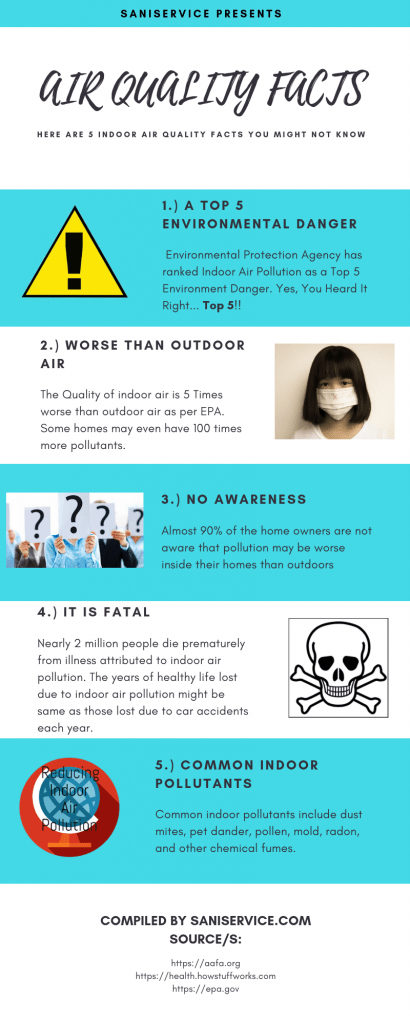
Here are some facts about indoor air quality presented in the form of an info-graphic. Indoor Air Quality is getting from bad to worse in recent years.
Indoor Air Quality Facts
- An average human breathes approximately 11000 litres of air each day, making ambient air pollution a major environmental problem.
- Environmental Protection Agency has ranked Indoor Air Pollution as a Top 5 Environment Danger.
- The quality of indoor air is 5x worse than outdoor air. Some homes may even have 100x more pollutants.
- Almost 90% of the home owners are not aware that pollution may be worse inside their homes than outdoors.
- Nearly 2 million people die prematurely from illness attributed to indoor air pollution. The population-wise years of healthy life lost due to indoor air pollution might be the same as those lost due to car accidents each year.
- Air Quality in schools is among the worst. Schools accommodate 4x more occupants than a standard office building with the same amount of floor space.
- Poor Quality Air Exacerbates Asthma – Asthma is a silent epidemic that has a disastrous effect on the quality of life. Every 1 in 13 people suffers from some form of Asthma.
- Dry eyes, headaches, nasal congestion, fatigue, and even nausea are common symptoms. Serious problems such as asthma, lung infections, or even lung cancer have been linked to exposure. Particles which enter the bloodstream were associated with stroke and depression in adults and children have shown increased systemic inflammation, immune dysfunction, and neural distress.
- The Elderly suffer the most from poor indoor air quality as they spend 18-20 hours at home every day. Elderly care centers faced exposure to high concentrations of fungus which could negatively affect their respiratory health.
- Kitchen is a hot spot of indoor air pollution – the cooking process can produce toxic pollutants like nitrogen dioxide, carbon monoxide, particulate matter & hydrocarbons which adversely affect your health.
- Common indoor pollutants include dust mites, pet dander, pollen, molds, radon, and other chemical fumes.
Prevention and Cure
- The easiest way to prevent indoor air pollution is to try not to bring pollutants inside your homes in the first place.
- The second step is to increase ventilation inside the house. Open your doors and windows to let in fresh air everyday especially during cooking.
- Clean your air ducts, furniture, rugs, carpets periodically and properly. Take professional duct cleaning help if needed.
- Check your ac and air cleaner filters regularly and replace them when needed.
- Monitor your health and get regular health checkups done to make sure you are not suffering from any respiratory disease.
- Eat a healthy diet. A healthy diet has the capacity to remove toxins out of your body. i
Sources: aafa.org , health.howstuffworks.com , epa.gov, globalhealingcenter.com

